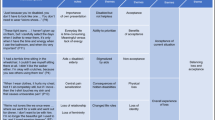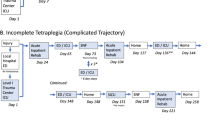Abstract
Study design:
Systematic review.
Objectives:
(1) To describe and compare follow-up care programmes, performed by rehabilitation centres, for persons with spinal cord injury (SCI) and (2) to describe the effects of these programmes regarding the occurrence of secondary impairments, well-being, the quality and costs of care.
Methods:
A systematic literature search was conducted in MEDLINE (1972–2003) and CINAHL (1982–2003). Publications were selected about medical and/or nursing follow-up care to SCI patients living in the community performed by or with rehabilitation facilities for SCI patients. The aim of the follow-up care should be a decrease of secondary impairments, an improvement of well-being, an improvement of the quality and/or a decrease of the costs of care.
Results:
The search resulted in 24 papers. The descriptions of the programmes in these papers were sometimes rather scattered, vague or brief. The most important methods were telemedicine (six programmes; of which five were performed in the same rehabilitation centre), outpatient consulting hours (six programmes), home visits (three programmes, and case management (one programme). Eight other programmes combined several methods (ie outpatient consulting hours, home visits, peer teaching and support, outings, ongoing support, therapy from several care disciplines, SCI education, providing SCI expertise and support to community health-care providers, coordination of care with community nursing agencies). In all, 16 programmes have been evaluated to some degree. In general the quality of the studies was low. Most evaluations were pre-experimental in design. Only three were quasi-experimental, and two programmes were experimental in design. Although several studies claimed positive effects, it was not possible to draw conclusions on the effect of follow-up care on the occurrence of secondary impairments, well-being, the quality and costs of care.
Conclusion:
There is a need for the development, the publication and the well-designed evaluation of follow-up care programmes for persons with SCI.
Similar content being viewed by others
Log in or create a free account to read this content
Gain free access to this article, as well as selected content from this journal and more on nature.com
or
References
Anson CA, Shepherd C . Incidence of secondary complications in spinal cord injury. Int J Rehab Res 1996; 19: 55–66.
Bloemen-Vrencken JH, de Witte LP . Post-discharge nursing problems of spinal cord injured patients: on which fields can nurses contribute to rehabilitation? Clin Rehab 2003; 17: 890–898.
Bloemen-Vrencken JHA, Post MWM, Hendriks J, De Reus ECE, de Witte LP . Health problems found in persons with spinal cord injury living in the Netherlands, 2004, accepted for publication in Disability and Rehabilitation.
Cox RJ, Amsters DI, Pershouse KJ . The need for a multidisciplinary outreach service for people with spinal cord injury living in the community. Clin Rehab 2001; 15: 600–606.
Ernst JL, Thomas LM, Hahnstadt WA, Piskule AA . The self-identified long-term care needs of persons with SCI. SCI Psychosocial Process 1998; 1: 127–132.
Glidden MM . Spinal cord injury and case management. Top Spinal Cord Inj Rehab 1999; 4: 16–23.
Mattson J . Case management: a historical and future perspective of its influence on outcome for persons who have sustained spinal cord injury. Top Spinal Cord Inj Rehab 1999; 4: 30–37.
Rawl SM, Easton KL, Kwiatkowski S, Zemen D, Burczyk B . Effectiveness of a nurse-managed follow-up program for rehabilitation patients after discharge. Rehab Nurs 1998; 23: 204–209.
Polit DF, Hungler BP . Nursing Research: Principles and Methods, 4th edn, Lippincott Company: Philadelphia, 1991.
Mathewson C, Adkins VK, Lenyoun MA, Schmidt AM, Jones ML . Using telemedicine in the treatment of pressure ulcers. Ostomy Wound Manage 1999; 45: 58–62.
Mathewson C, Adkins VK, Jones ML . Initial experiences with telerehabilitation and contingency management programs for the prevention and management of pressure ulceration in patients with spinal cord injuries. J Wound Ostomy Continence Nurs 2000; 27: 269–271.
Phillips VL, Temkin AJ, Vesmarovich SH, Burns R . A feasibility study of video-based home telecare for clients with spinal cord injuries. J Telemed Telecare 1998; 4: 219–223.
Phillips VL, Temkin A, Vesmarovich S, Burns R, Idleman L . Using telehealth interventions to prevent pressure ulcers in newly injured spinal cord injury patients post-discharge. Results from a pilot study. Int J Technol Assess Health Care 1999; 15: 749–755.
Phillips VL, Vesmarovich S, Hauber R, Wiggers E, Egner A . Telehealth: reaching out to newly injured spinal cord patients. Public Health Rep 2001; 116 (Suppl 1): 94–102.
Weinel D . The sunshine network teleconsultation initiative for SCI veterans in community settings. SCI Nurs 2000; 17: 22–23.
Barber DB, Woodard FL, Rogers SJ, Able AC . The efficacy of nursing education as an intervention in the treatment of recurrent urinary tract infections in individuals with spinal cord injury. SCI Nurs 1999; 16: 54–56.
Dover H, Pickard W, Swain I, Grundy D . The effectiveness of a pressure clinic in preventing pressure sores. Paraplegia 1992; 30: 267–272.
Dunn M, Love L, Ravesloot C . Subjective health in spinal cord injury after outpatient healthcare follow-up. Spinal Cord 2000; 38: 84–91.
Ferguson I . Growing a SCI support clinic – in the VA health care system. SCI Psychosocial-Process (SCI-PSYCHOSOC-PROCESS) 2000; 13: 129–132.
Lapierre NM . Innovative approach in rehabilitation nursing: providing primary care to tertiary care patients. Can J Nurs Leadersh 1999; 12: 23–24.
Remington H . How successful has a nurse-managed outpatient SCI clinic been in your hospital? SCI Nurs 1991; 8: 30.
Beer NI . The role of the home visiting nurse in the total education programme of spinal cord injured persons. Paraplegia 1984; 22: 311–315.
Fine PR, Better SR, Engstrand JL . The operation of a hospital based specialty home health team: activities and associated costs. Arn J 1978; 3: 5–11.
Jones HW . A follow-up service-supplemented by domicillary visits. Paraplegia 1972; 10: 111–114.
Cioschi HM, Goodman CL . A lifetime case management model for persons with spinal cord injury. J Case Manag 1994; 3: 117–123.
Beck LA, Scroggins LM . Optimizing health of individuals with tetraplegia. SCI Nurs 2001; 18: 181–186.
Brown DJ, Judd FK, Ungar GH . Continuing care of the spinal cord injured. Paraplegia 1987; 25: 296–300.
Dinsdale S, Thurber D, Hough E, Rencz S . Community based monitoring for spinal man. Can J Public Health 1981; 72: 195–198.
Duci B, Saperstein I . SCI home care: transitional rehabilitation as a component of follow-up care. SCI Nurs 1986; 3: 6–9.
Lathbury K . The road ahead – managing a spinal cord injury. Case Manager 2000; 11: 55–57.
Pollack SF, Zuger RR, Walsh J . Moving out services for education and support (MOSES): a model program for individuals with spinal cord injury. SCI Nurs 1992; 9: 79–82.
Steinberg FU . The management of patients with spinal cord injury by a hospital-based home care programme. Paraplegia 1975; 12: 246–250.
Warner BH, Taylor SK . Follow-up care evaluation: patient perspective. Rehab Nurs 1982; 7: 13–16, 24.
Acknowledgements
The study was supported by the Netherlands Organisation for Health Research and Development, ZonMw, Rehabilitation programme, Grant no. 014 32 030.
Author information
Authors and Affiliations
Rights and permissions
About this article
Cite this article
Bloemen-Vrencken, J., de Witte, L. & Post, M. Follow-up care for persons with spinal cord injury living in the community: a systematic review of interventions and their evaluation. Spinal Cord 43, 462–475 (2005). https://doi.org/10.1038/sj.sc.3101750
Published:
Issue date:
DOI: https://doi.org/10.1038/sj.sc.3101750
Keywords
This article is cited by
-
The effect of rurality and distance from care on health outcomes, environmental barriers, and healthcare utilization patterns in persons with traumatic spinal cord injury
Spinal Cord (2023)
-
Primary Care in the Spinal Cord Injury Population: Things to Consider in the Ongoing Discussion
Current Physical Medicine and Rehabilitation Reports (2023)
-
Interdisciplinary follow-up clinic for people with spinal cord injury: a retrospective study of a carousel model
Spinal Cord Series and Cases (2021)
-
A community-based intervention to prevent serious complications and death 2 years after discharge in people with spinal cord injury in Bangladesh (CIVIC): a randomised trial
Spinal Cord (2021)
-
Understanding how a community-based intervention for people with spinal cord injury in Bangladesh was delivered as part of a randomised controlled trial: a process evaluation
Spinal Cord (2020)



